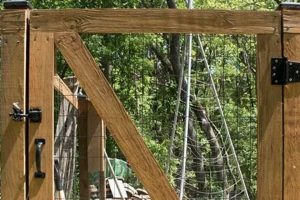The construction and installation of safety barriers along staircases, undertaken as a personal project, offer a variety of design and material choices. For example, homeowners may choose to construct a railing from wood, metal, or a combination of materials, customizing the design to complement existing decor.
These personalized projects provide opportunities for cost savings compared to professional installation. Furthermore, they allow for increased customization, enabling homeowners to create unique features that reflect their personal aesthetic. Historically, this type of project allowed greater accessibility to home improvement, even with limited resources.
The following article will explore different material selections, design considerations, and safety standards relevant to constructing these structures, providing information necessary for successful project completion.
Important Considerations for Stairway Safety Barriers
The following are crucial points to consider when planning the construction and installation of safety barriers along staircases. Prioritizing safety and adherence to regulations is paramount.
Tip 1: Code Compliance: All constructed stairways must comply with local building codes and regulations, regarding height, spacing between balusters, and load-bearing capacity. Failure to comply can result in mandated reconstruction.
Tip 2: Material Selection: The choice of material, whether wood, metal, or composite, must be suitable for the intended use. Consider factors such as durability, weather resistance, and maintenance requirements to prevent premature deterioration and structural failure.
Tip 3: Secure Mounting: The railing must be securely anchored to the staircase structure to withstand anticipated loads. Insufficiently attached railings pose a serious safety hazard. Consult structural guidelines to ensure proper attachment methods.
Tip 4: Baluster Spacing: Baluster spacing must adhere to safety standards to prevent children and pets from passing through. Typically, a maximum spacing of 4 inches is required to minimize the risk of accidents.
Tip 5: Handrail Height: The handrail height must be within a specified range to provide a comfortable and secure grip for users of various heights. Review applicable codes for exact height requirements.
Tip 6: Smooth Surfaces: All surfaces must be free of sharp edges, splinters, or other hazards that could cause injury. Sanding and proper finishing are essential for ensuring user safety.
Tip 7: Regular Inspection: Regularly inspect the railing for signs of wear, damage, or loose connections. Promptly address any identified issues to maintain the structural integrity and safety of the structure.
Adherence to these guidelines ensures the safety and longevity of the staircase structure, creating a secure environment for its users.
The following section will address various design styles, offering ideas for creating a customized feature, while maintaining the strict requirements outlined above.
1. Material Selection
Material selection is a foundational element in the construction of safety barriers along staircases. The choice of material directly influences structural integrity, aesthetic appeal, and overall project cost. In a personal construction project, the available materials and their properties dictate the final product’s viability. For example, using untreated softwood might be a cost-effective initial choice but will likely result in premature decay and structural compromise if exposed to moisture or high traffic. Conversely, selecting a hardwood such as oak or maple provides greater durability and a refined appearance, albeit at a higher cost. The impact of material selection is evident in longevity and maintenance needs. A poorly chosen material can negate the benefits of skilled craftsmanship and design ingenuity.
Practical considerations further influence material choices. For metal railing projects, steel offers strength and weldability but requires protection against corrosion. Aluminum provides corrosion resistance but may lack the structural rigidity of steel for certain designs. Composite materials, such as those made from recycled plastics, present an alternative with low maintenance and weather resistance, though their aesthetic qualities may not suit all applications. The weight of the chosen material also impacts the installation process. Heavier materials necessitate more robust anchoring and may require professional assistance, whereas lighter materials enable easier handling and modification. Prior to embarking on a personal project, material compatibility with existing structural elements and planned finishes warrants careful evaluation.
In summary, the material selected for a personal stair railing project has profound implications for safety, durability, and overall aesthetic success. Evaluating material properties against project requirements and environmental conditions is critical. Failure to consider these factors can lead to structural deficiencies, increased maintenance costs, and a compromised final result. Proper material selection, therefore, represents a crucial aspect of responsible and effective project management, directly contributing to the long-term value and safety of the structure.
2. Design Aesthetics
Design aesthetics play a pivotal role in the success of any personal stair railing project. The visual appeal of the structure directly influences the perceived value of the entire space, and its correlation with existing architectural styles is critical. A railing design that clashes with the home’s overall aesthetic can detract from the property’s value and create a sense of visual disharmony. Conversely, a well-designed structure enhances the space, serving as a focal point and increasing the perceived elegance of the interior.
The incorporation of design aesthetics extends beyond mere visual considerations. It also encompasses ergonomic factors and user experience. A railing that is aesthetically pleasing but difficult to grip or navigate represents a failure in design. Ergonomic considerations, such as handrail shape and smooth transitions, enhance both safety and usability. Examples include minimalist designs that complement modern interiors, rustic wood railings that enhance country-style homes, and ornate metal structures that echo Victorian architecture. Each style requires careful consideration of proportions, materials, and finishes. The scale of the staircase, the surrounding lighting conditions, and the intended user demographic must all inform the design process.
In conclusion, design aesthetics are not merely superficial embellishments but integral components of a successful project. The ability to blend visual appeal with functional requirements defines a well-executed railing. Challenges include balancing personal preferences with e
stablished design principles and adhering to budget constraints without compromising quality. The effective integration of design aesthetics elevates a simple safety feature into a statement of individual style and architectural refinement.
3. Code Compliance
In personal construction projects involving safety barriers along staircases, adherence to local building codes is paramount. These regulations establish minimum safety standards to protect occupants from injury and ensure structural integrity. Neglecting code compliance can result in legal penalties, mandated reconstruction, and, more importantly, increased risk of accidents.
- Handrail Height and Gripping Surface
Building codes specify the required height range for handrails above the stair treads. Furthermore, they often dictate the acceptable gripping surface dimension and profile. Failure to comply can make the railing unusable or unsafe for certain individuals, potentially leading to falls. An example is a handrail installed too low or with an excessively large diameter, rendering it difficult to grip securely. Proper handrail height and profile are crucial for users of all ages and abilities.
- Baluster Spacing and Infill Requirements
To prevent children and pets from passing through the railing, building codes mandate maximum spacing between balusters or other infill materials. Typically, this spacing is limited to four inches. Openings larger than this pose a significant safety hazard. An example of non-compliance is a railing with widely spaced balusters, allowing a small child to fall through. The infill material must also be strong enough to withstand reasonable force, preventing it from being easily dislodged or broken.
- Load-Bearing Capacity and Structural Stability
Stair railings must be designed and constructed to withstand specific loads, as defined by building codes. These loads include vertical and horizontal forces exerted by users. Insufficient structural capacity can lead to railing collapse under stress. An example is a railing constructed with undersized posts or inadequate anchoring, resulting in instability and potential failure. Engineering calculations and appropriate material selection are essential for ensuring structural stability.
- Guardrail Height and Extension Requirements
In addition to handrails, guardrails are required on open sides of stairways and landings to prevent falls. Building codes specify the minimum height for guardrails, typically 42 inches above the walking surface. Also, the handrail or guardrail must extend beyond the top and bottom risers a specified distance and return to a wall, guard post, or the walking surface, preventing clothes from catching and causing a fall at the top or bottom of the stair. An example of non-compliance is a guardrail that is too short or fails to extend adequately. Ensuring proper guardrail height and extension is critical for preventing falls, especially on staircases with open sides.
These facets demonstrate the critical link between building codes and construction projects involving safety barriers along staircases. Compliance with these regulations is not merely a formality but a fundamental requirement for ensuring user safety and structural integrity. Failure to adhere to these standards can have severe consequences, underscoring the importance of thorough planning and diligent execution.
4. Structural Integrity
Structural integrity represents a non-negotiable facet of personalized safety barrier projects along staircases. The capability of the railing to withstand applied loads and environmental stresses directly dictates its effectiveness as a safety device. Without adequate structural integrity, the barrier’s ability to prevent falls or provide support is compromised, rendering it a liability rather than an asset. The connection between these projects and structural integrity is a cause-and-effect relationship: insufficient attention to structural design and construction inevitably results in a weakened, unreliable structure. For instance, a railing constructed with inadequately sized posts or improperly secured to the staircase will likely fail under the force of a person leaning against it, leading to potential injury. Consequently, structural integrity is not merely a desirable feature; it is a foundational requirement.
Consider the practical implications: A railing constructed from lightweight materials and attached with insufficient fasteners may initially appear aesthetically pleasing. However, over time, repeated use and environmental factors such as temperature fluctuations and humidity can weaken the connections and degrade the materials. This degradation can lead to instability, resulting in a compromised safety barrier. Conversely, a railing designed with structural considerations, incorporating robust materials, secure anchoring methods, and appropriate load-bearing capacity, provides a stable and reliable safety feature. This type of project requires more detailed planning and potentially higher initial investment, but it guarantees long-term safety and minimizes the risk of failure. The importance of structural integrity extends beyond immediate safety concerns. A structurally sound railing also contributes to the long-term value of the home by preventing costly repairs and replacements. A well-built railing becomes a permanent fixture.
In summary, structural integrity is the cornerstone of all stair railing construction projects. Emphasizing robust design principles, appropriate material selection, and secure installation methods is critical. Failure to prioritize these elements can lead to structural deficiencies, creating an unsafe environment. The challenge lies in balancing aesthetic preferences with the strict requirements of structural stability. Successful projects integrate visual appeal with the foundational element of structural soundness, yielding a visually pleasing and, above all, structurally reliable safety barrier.
5. Installation Methods
Effective installation methods are intrinsic to the successful execution of personalized safety barrier projects on staircases. The choice of installation technique and the precision with which it is applied directly affect the structural integrity, stability, and longevity of the finished product. Improper installation can negate the benefits of high-quality materials and thoughtful design, resulting in a safety hazard. For instance, a railing post inadequately anchored to the staircase frame will compromise the entire structure, regardless of the post’s strength or aesthetic appeal. The installation process, therefore, serves as the critical link between design conception and functional reality. The stability and secure fixing of all project components is key for safety.
The selection of appropriate installation methods necessitates a thorough understanding of the staircase’s underlying structure and the properties of the chosen materials. Wood staircases typically benefit from screw-fastened connections, often reinforced with adhesives, to distribute stress and prevent loosening over time. Metal staircases may require welding, bolting, or spec
ialized anchoring systems to achieve comparable stability. Concrete staircases present unique challenges, often necessitating the use of epoxy adhesives or expansion anchors to ensure a secure and lasting bond. An example of this is the installation of a metal railing on a concrete staircase requiring careful drilling and anchor placement to prevent cracking or spalling of the concrete. Proper tools, safety gear, and knowledge of construction techniques are essential for safe and effective execution.
In summary, the effective execution of safety barrier projects hinges on the rigorous application of appropriate installation methods. This requires a comprehensive understanding of material properties, structural mechanics, and relevant building codes. Overlooking this aspect can lead to structural deficiencies, compromising the safety and functionality of the barrier. Emphasis on proper installation techniques and adherence to safety standards are key for project longevity.
Frequently Asked Questions Regarding Stairway Safety Barrier Projects
The following section addresses common inquiries concerning the construction and installation of safety barriers along staircases. The provided information aims to clarify uncertainties and promote informed decision-making.
Question 1: What are the primary safety regulations that must be considered in stair railing construction?
Primary safety regulations pertain to handrail height, baluster spacing, load-bearing capacity, and code compliance. Handrail height typically ranges between 34 and 38 inches above the stair treads. Baluster spacing should not exceed 4 inches to prevent small children from passing through. The railing must withstand a specified load, typically 200 pounds. Lastly, all construction must adhere to local building codes.
Question 2: Which materials are most suitable for constructing a durable and safe stair railing?
Suitable materials include hardwoods like oak or maple for their strength and durability, steel for its high load-bearing capacity, and composite materials for their weather resistance and low maintenance. Material selection depends on aesthetic preferences, budget constraints, and environmental conditions.
Question 3: What tools are essential for undertaking a DIY stair railing installation?
Essential tools include a measuring tape, level, drill, saw (circular or miter), safety glasses, gloves, and appropriate fasteners (screws, bolts, or adhesives). Depending on the material chosen, welding equipment or specialized concrete anchors may also be necessary.
Question 4: How can one ensure that a stair railing is securely anchored to the existing staircase structure?
Secure anchoring requires appropriate fasteners and installation techniques. For wood staircases, screws and adhesives are typically sufficient. For metal or concrete staircases, welding, bolting, or epoxy anchors may be required. Consulting structural guidelines is advisable to determine the appropriate anchoring method.
Question 5: What are the common mistakes to avoid when constructing and installing a stair railing?
Common mistakes include neglecting code compliance, using undersized materials, failing to properly anchor the railing, and overlooking ergonomic considerations. Thorough planning, attention to detail, and adherence to safety standards are essential for avoiding these errors.
Question 6: How frequently should a stair railing be inspected for signs of wear or damage?
A stair railing should be inspected at least twice annually for signs of wear, damage, or loose connections. Promptly addressing any identified issues can prevent further deterioration and maintain the safety of the structure.
These answers provide a general overview of key considerations in stairway safety barrier projects. Consulting with qualified professionals is recommended for specific project requirements.
The following segment will explore design ideas for safety barrier structures.
Conclusion
The preceding exploration of “diy stair railing ideas” has underscored the importance of safety, structural integrity, code compliance, and aesthetic considerations. Material selection, proper installation methods, and adherence to established guidelines are critical to the success of any personal project of this nature.
A well-executed stair railing provides safety for years to come. Careful planning and attention to detail ensures the creation of a safety feature that is both functional and visually appealing. The construction of a robust and visually harmonious structure is achievable through diligent research and skilled execution, ensuring user safety and the long-term value of the home.







